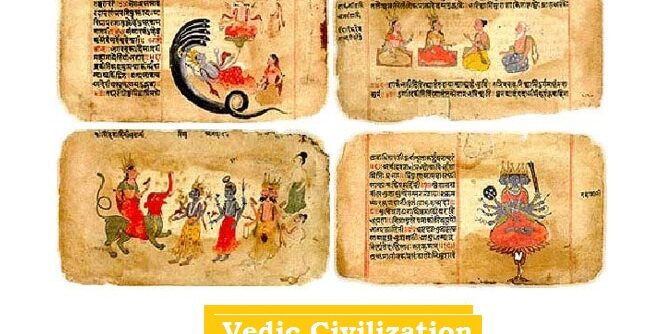
Vedic Civilization started with the arrival of Aryans into the Indian Sub-continent and settled in the Indus region (known as land of seven rivers ‘Saptasindhu’) around 1500 BC from Central Asian regions. Aryans had conflicts with the indigenous inhabitants (‘Dasas’ or ‘Dasyus’) and also among themselves (5 Aryan tribes).
They owed their success in their use of horses, chariots and better arms. Bharatas- the Aryan tribe, joined hands with Purus to form Kurus and later with Panchalas and established their rule in upper Gangetic basin.
Polity:
- There was no integrated political organization as they were in a state of perpetual expansion, migrating from one place to another.
- Tribal chief was the head (‘Rajan’) who was to protect the whole tribe and cattle, fought wars and offer tributes.
- He was assisted by Purohit (priest- Vashishtha and Vishwamitra being very famous) and Senani (warfare user- spears, axes)
- Several tribal or clan based organizations (Sabha, Samiti, or Gana) were exercising deliberative, military and religious functions. Women attended them.
Family and Society:
- Kinship was the basis of social structure, people were identified by the clan they belong.
- People gave primary loyalty to their tribe (‘Jana’), and family (‘Kula’) was rarely mentioned in Rigveda.
- It was a patriarchal joint family headed by the male member, and therefore birth of son was desired.
- The division of society on the basis of occupation has started but not very sharp. There were Arya Varna (fair complexion) and conquered Dasa Varna (dark complexion).
- Gradually, the tribal society was divided into three groups– Warriors, Priests and the people, and the fourth division- Shudra appeared towards the end of Rigveda age, used as slaves.
Economy (Material life):
- The society was mainly pastoral, though agriculture was known to them.
- Most of the wars were fought for the sake of cows and bulls. Gifts made to priests consisted of women slaves and cows and not lands.
- As territory was not yet established, there were no taxes and king was getting voluntary offerings (‘Bali’).
- Trough trade was missing, there were also artisans like carpenters, chariot makers, weavers, potters, smiths, etc.
Religion:
- Religion was discovered from surroundings and natural forces, which were personified and worshiped.
- Indra- the god of war, rain; Agni- the god of fire, which was an intermediary between God and people; Varuna- the god of water, air
- They were worshiped through recitation of prayers and offering of sacrifices to get their blessings. (Ritual or formula of worship was missing)
Later Vedic Civilization (1000- 500 BC)
In the Later Vedic Period, Aryans moved towards east into the Gangetic plains, agriculture became more important and territorial kingdoms were established, Varna system was well developed.
Political organisation:
- Territorial kingdom were established and king
position became more powerful.
- His influence was strengthened by the Brahamanas through rituals.
- He received voluntary gifts from the people (‘Bali’)
- Popular assemblies lost importance, as the
nature of sabha and samiti changed to be dominated by the nobles and brahmanas.
(Women were no longer permitted to attend)
There was no standing army in this period too.
Family and Society:
- Power of male head increased and women were relegated to inferior and subordinate position
- Institution of Gotra appeared and exogamous marriage was practiced.
- Ashram System started- Brahmacharya, Grihasta, Vanprastha and Sanyas as the four states of life.
- Society was divided into four varnas- Kshatriya, Brahamana, Vaishya, Shudras. Growing cult of sacrifice increased the power of Brahamans.
- Vaishyas constituted the common people and were assigned productive activities like agriculture, cattle rearing, artisans, etc. They were the tribute paying.
- The Shudras were servants of other groups and were not entitled to many social customs.
Economy:
- Territory (or land) became important as asset and agriculture became primary means of livelihood
- Tools made up of iron were used for the first time to clear forests and for ploughing.
- With barley, rice and wheat became important in the doab regions of Ganga and Yamuna
- Collection of taxes and tributes developed as the life became settled and organised.
- There was a rise of diverse art and crafts, smiths and smelters developed after the discovery of iron in this period
- Weaving became confined to women and other arts like pottery, leather work, and carpentry made great progress.
- Painted Grey Ware (PGW) became the most distinctive pottery, which used fine, grey pottery painted with geometric patterns in black. (Also called PGW Culture)
Religion:
- The Nature Gods lost their importance and Prajapati (the creator), Vishnu (the preserver) and Rudra (the destroyer) became important.
- Mode of worship changed and rituals and sacrifices became more important. Brahmanas became mediator between people and God and hold a monopoly.
- Objects began to be worshiped as symbols of divinity and idolatry appeared.

 Home
Home Syllabus
Syllabus Contact Us
Contact Us




